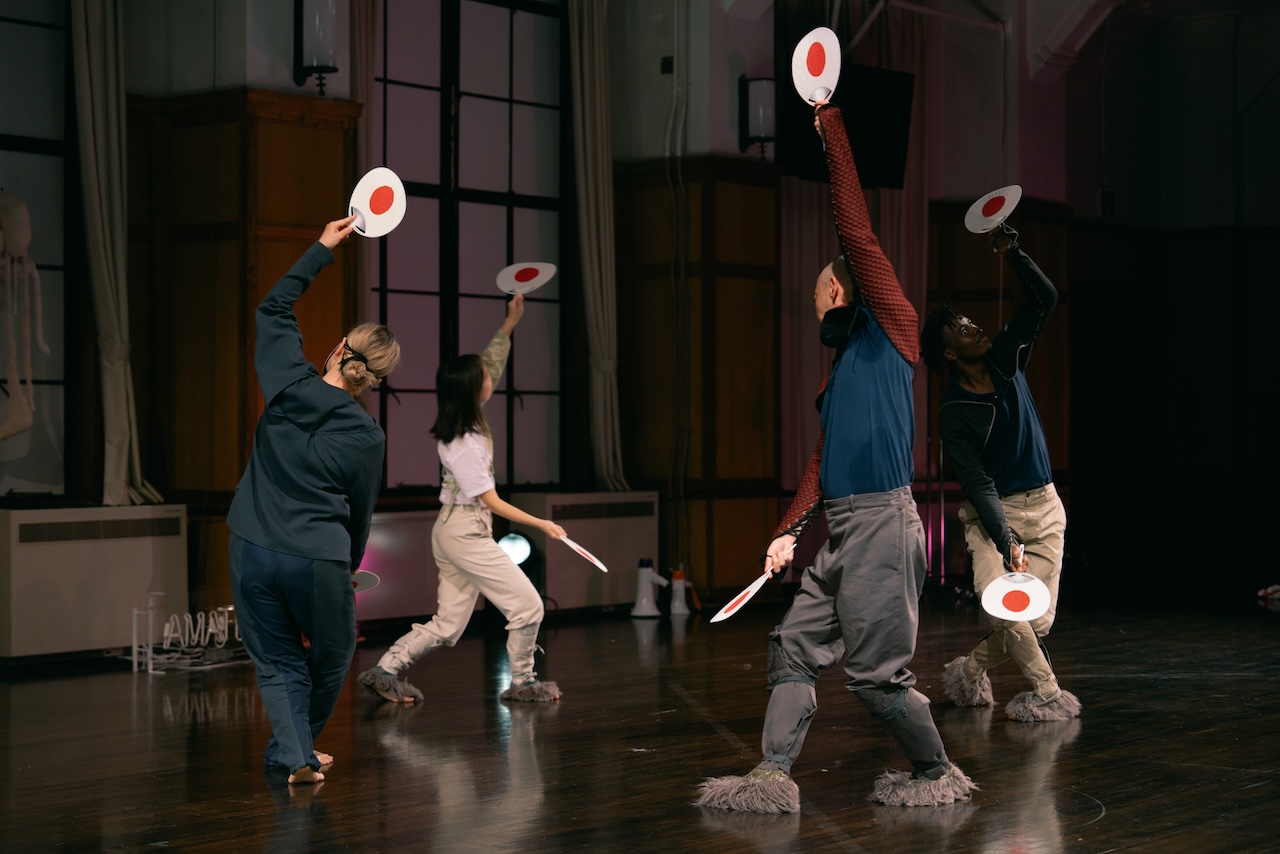【批評家・イン・レジデンス】文:フレダ・フィアラ
2025.6.13 (Fri)
2024年のフェスティバル会期(10月5日~27日)に合わせ、EU代表部が主催、ゲーテ・インスティトゥート東京が運営する「批評家・イン・レジデンス@KYOTO EXPERIMENT 2024」が開催されました。参加したEU出身の批評家によるレポートを掲載します。(英文和訳:Art Translators Collective)
KYOTO EXPERIMENT 2024: 関西の「フリンジ」、15周年を迎える
フレダ・フィアラによる考察
真っ白なクリームのケーキには赤いソースが垂らされ、「15」の数字を象った黒いロウソクが刺さっている。下に走り書きされた署名は判読できないほど絡み合い、それがかえって人の目を引く。2024年10月、このイメージは京都の街を行き交う人々を出迎え、KYOTO EXPERIMENT(以下、KEX)の15周年を記念して至るところに姿を現した。本質的にカワイイこのモチーフは、その文化的文脈において「カワイイ」が単なる可愛らしさを超えて社会的影響力を持ち、社会政治的な意味合いを帯びた美意識へと昇華する様を雄弁に物語っている。2010年に橋本裕介のディレクションのもと創設されて以来、KEXは関西において演劇、ダンス、ジャンル横断的パフォーマンスの重要な拠点となってきた。2020年からは川崎陽子、塚原悠也、ジュリエット・礼子・ナップという、多くの人が「トリオ」と呼ぶ共同ディレクター体制のもと新たな道を歩み始め、アジア域内でネットワーク構築、協働、共同制作を推進する活動との連携を深めている。また、15周年となる今年、駐日欧州連合代表部の主催でゲーテ・インスティトゥートが運営を担いKEXと公益財団法人セゾン文化財団の協力のもと、初の試みとして「批評家・イン・レジデンス」プログラムのホストとなり、ウルリケ・クラウトハイムがディレクションを、平野春菜がコーディネートを務めた。刺激的な視点を持つ批評家たちとともにこのプログラムに参加する機会を得られたことを、私はこの上ない幸運だと感じている。4週間に及ぶ密度の濃い時間のなかで、私たちは本フェスティバルのさまざまなプログラムに深く関わり、その理念と目標について貴重な気づきを得ることができた。本稿では、そのキュレーションのレンズを通して、KEXが近年力を入れている地域ネットワークの構築に焦点を当て、それを顕著に示す作品をいくつか紹介していきたい。
暑さが残る10月最初の週末、KEXは京都市役所本庁舎の屋上庭園テラスにてインドネシア人アーティスト、ムラティ・スルヨダルモの長時間にわたるパフォーマンス『スウィート・ドリームス・スウィート』で開幕を迎えた。この作品は2013年のジャカルタ・ビエンナーレで初演され、これまでさまざまな形で上演を重ねてきたが、今回は京都市立芸術大学の学生たちをはじめ、京都で募集した人たちととともに新たな挑戦を行った。照りつける秋の日差しのもと、日傘を差した観客たちが見守るなかで、白装束のパフォーマーたちはクライン・ブルーの絵具が満たされた桶にゆったりと足を浸していた。スルヨダルモの作品では、インドネシアのルーツとドイツで受けた西洋パフォーマンス・アートの影響を交差させながら、この二つの表現様式が対照的に描き出されている。深いクライン・ブルーとコントラストをなす純白の衣装は、インドネシアの学校で毎週月曜日に着用する制服を想起させる。また京都芸術センターでは、地元の観客にスルヨダルモの代表作をより深く知ってもらうため、1ヶ月間の映像展も併せて開催された。
KEXプロデュースの作品として始めに見たのは、THEATRE E9 KYOTOで上演された松本奈々子&アンチー・リン(チワス・タホス)の共同作品『ねばねばの手、ぬわれた山々』だった。この作品はクィア・フェミニズムの視点を通して生態史にまつわる物語を展開する。インスタレーションとパフォーマンスが融合した空間には、異なる時代や土地の記憶を宿した品々が配置されていた。日本と台湾に自生するクスノキ、水盤の上に吊るされた庭師の手袋、そして手漉きの紙。この紙は、チワスの属するタイヤル族など、台湾原住民を記録した植民地時代の公文書を参照したものだった。この作品は芸術的な調査研究の視点から、従来とは異なる歴史の描き方や、個人の出会いが集合的な記憶を形成していく過程に迫っている。採取主義に対するエコクリティシズム的な手法を土台としながら、タイヤル族(テマハホイ)と日本(山姥)それぞれの伝承からも着想を得た本作は、KEXと台北パフォーミングアーツセンター(TPAC)による初の共同作品としても位置付けられる。
フェスティバル後半には、穴迫信一と捩子ぴじんによる『スタンドバイミー』が堀池御池ギャラリーで上演された。ミュージシャンのテンテンコとの協働で生まれたこの新作は、不条理な風刺と成長物語の要素を織り混ぜ、スティーヴン・キングを彷彿とさせるような形で危機とアイデンティティを探求している。本作では、自然災害が起き、同日に殺人事件も発生した後の世界を舞台に、亡者となった登場人物たちが非現実的な世界をさまよう。彼らが能楽堂を訪れ、伝統の中に答えを探ろうとする場面で物語は転機を迎える。出演した能楽師の田中春奈が穏やかな口調で丁重に「伝統にも普遍的な答えはない」と語ると、観客は気まずそうに笑いを漏らした。その笑いには、機知に満ちた表現の下に隠された、人間の無力さへの共感が込められていた。ラストシーンでも、伝統を敬いながらもそこからの逸脱を試みるような動きが続く。一人のパフォーマーがギャラリーの裏口から路上へと歩み出る仕草は能舞台の橋掛かりを思わせ、まるで異次元への越境さえも簡単にできるかのようだった。
私が特に注目したのは、京都を拠点に活動するアーティスト、余越保子による『リンチ(戯曲)』だ。伝統に対して探求的なアプローチを取ることで知られる作者が振り付けを手がけた本作は、フェスティバル最後の週末に上演された。本作は作家、羽鳥ヨダ嘉郎の濃厚で詩的な作品を原作としている。原作では、東南アジアにおける日本の帝国主義という難しいテーマに向き合っている。余越の振り付けは、こうした歴史的素材の集積から象徴的な風景を紡ぎ出し、そこに文化的伝統とポストモダンな混淆性との対置を織り込んでいった。パフォーマーたちは能面をはじめとするさまざまなファウンド・オブジェクトを用いて正統性や専門性という概念を打ち壊し、また地謡を通して身体という境界やそれが主張する個としての存在に疑問を投げかけた。広島出身のアーティストである余越自身の診療記録といった個人的な要素も取り入れられ、集団の責任や人類の進歩が遺した功罪について多角的な視点から考察を加えている。これほど大胆に過去と向き合う試みは珍しい。余越の『リンチ(戯曲)』は、世界中のより多くの観客に触れてもらいたい作品だ。
KEXの主要プログラムに加え、京都と埼玉で開催する「ダンス リフレクションズ by ヴァン クリーフ&アーペル フェスティバル」の一環として、ダンス リフレクションズ by ヴァン クリーフ&アーペルのダンスプログラムが上演された。フランスとの結びつきが強いこの企画では、マチルド・モニエ&ドミニク・フィガレラの『ソープオペラ、インスタレーション』や、(ラ)オルド×ローン with マルセイユ国立バレエ団によるレイヴさながらの『ルーム・ウィズ・ア・ヴュー』など、比較的親しみやすい作品が揃い、難解な作品が多いKEXのプログラムとは対照的だった。だが、ロイ・フラーの「サーペンタインダンス」を再解釈したオラ・マチェイェフスカの『ボンビックス・モリ』のように、より複雑な試みもあった。ただし残念ながら、この作品はフラーと日本の関係がはらむ問題、とりわけヨーロッパでジャポニズムを掲げて貞奴や花子らとパフォーマンスを行ったことなど、重要な点には触れていなかった。
専門家を招いたトークプログラム「Super Knowledge for the future[SKF]」や、5年目を迎えた「Kansai Studies」など、フェスティバルの関連企画では芸術にまつわるリサーチと実験的な試みが深められていった。中でも注目を集めたのが、オフェリア・ジアダイ・ホァンによる「Future Dictionary」である。地元のアーティストとともに現代の芸術実践とキュレーションの手法を探究するこの展示は、観客が参加できる形で開催された。この展示では「妖怪ボディ」や「作品」など、パフォーマンスをめぐる従来の用語体系に新たな概念的広がりをもたらす言葉が提示された。この土地ならではの視点からフェスティバルを捉え直す試みであり、このような概念的枠組みが、地域に根差した文化とより広い芸術的探究との接点を見出す可能性を示唆していた。また今回の展示は、パフォーマンスをめぐる現代の議論を脱中心化していく上で、翻訳できない概念や言葉を生産的なものとして捉えていく必要性を示していた。古いトラウマと新しい形の暴力に満ちた今日の世界で、私たちはどのように共に進んでいけるのか。「Super Knowledge for the Future」で行われたトークでは、未来は本質的に不確実で不安定なものであり、予測は意味をなさず、決断はすべて「賭け」のようなものだという指摘があった。寺社や文化遺産が数多く残る京都は、歴史の変遷を今なお感じさせる土地だ。このフェスティバルにとって最良の「賭け」とは、その名の通り「実験」という姿勢を貫くことではないだろうか。
<執筆者プロフィール>
フレダ・フィアラ
舞台芸術研究者、キュレーター。オーストリア科学アカデミーのフェローであり、演劇・映画とメディア学、中国学をウィーン、ベルリン、香港、台北で学ぶ。東アジアのパフォーマンス文化と異文化関係に焦点を当てている。また、オーストリアのOK in Linzで開催されたパフォーマンスフェスティバル「The Non-fungible Body?」と、「HYBRID BODIES」をキュレーション。ウィーン美術アカデミー、ウィーン大学でパフォーマンス理論を教え、DISTANZ Verlag、PAJ / MIT Press、台北市立美術館、台北パフォーミングアーツセンター等から出版している。
